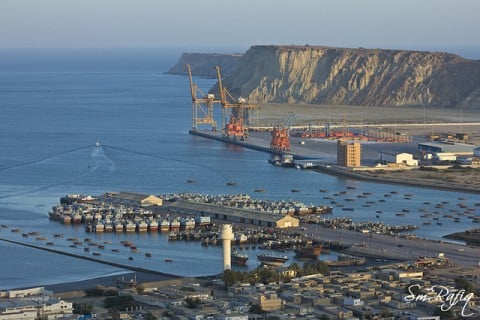Pakistan is building a port at the southwestern city of Gwadar on the mouth of the oil rich Persian Gulf. It provides an economical route for the flow of Central Asia’s natural resources to the world along with easy access to the growing consumer markets of Asia.
This article conceptualizes the Gwadar facility as a hub port that will contribute significantly to the revival of Pakistan’s economy. China mainly funded and completed the first phase of the Gwadar port in 2005. Islamabad is presently negotiating with private investors for the construction of the second phase. This article demonstrates the necessity of a white paper promulgating policies to attract foreign investment. The United States and key regional players are likely to view Chinese involvement in the Gwadar port project with suspicion. Any potential Chinese long-term military presence in the region will pose complications for Pakistan. The United States may request military basing rights at the Gwadar port to handle some future turbulent situation in the region. Any such eventually would require Pakistan to strike a difficult balance between a time-tested friend and an alley. Pakistan must enunciate a policy of non-military use of the Gwadar port for foreign powers to help stimulate Pakistan’s economic revival.
Also see : Gwadar Port: Challenges and Opportunities
Gwadar port is the largest and the deepest sea port in the middle of the world. On February 18, Pakistan transferred control of its strategically-located deep-sea port at Gwadar, Baluchistan province to China.
Gwadar’s 90% business is sea to sea and it does not need a large road network. The commercial importance chiefly stems from its natural layout and depth that enables largest tonnage ships to harbor there, a characteristic which is absent in Dubai and Chchbahar ports.
Central Asia is a land-locked region; its best access to warm waters is through Pakistan and Afghanistan or through Iran. The situation of Afghanistan seems unstable in the future and UN/ US sanctions or Iran are unlikely to be lifted for many years making the China –Pakistan route the best option for Central Asia.
China has long had the ambition of setting up a warmwater port, Gwadar is a strategic dream come true. China wants to set up outposts located along its energy lines across the globe to monitor and safeguard energy flows.
Gwadar is situated on the Arabian sea, just 180 nautical miles (330 kilometers) from the strait of Hormuz, through which a third of the world’s oil supply passes. It is a prime location to monitor shipping passing through the Strait of Hormuz from the Persian Gulf, it also provides access to cheap land routes or Middle East trade through Pakistan into western China and Central Asia. It is a deepwater port built with help from Chinese money and has been run by a Singaporean company until no. the port of Singapore Authority wasted a decade without development possibly under the influence of countries averse to Pakistan’s national interests.
The Pakistan People’s Party led government signed the Gwadar agreement with China, the previous government had opted in 2007 for the Port Authority of Singapore not to upset Washington even though China was providing 75 % of the $US250 million cost of construction.
For China, the port agreement provides enormous potential benefits. Lin Boqiang, director of Energy Economics Research centre at Xiamen University, explained: “I do believe China will build the port at the astonishing ‘Chinese speed’ to materialize the port’s strategic values.”
It offers a shorter route to western China—via the recently expanded Karakoram highway across Gilgit-Baltistan in northern Pakistan—and an alternative route to vulnerable sea lanes through the Strait of Malacca.
China is expected to build a naval base at Gwadar and its navy would maintain a regular presence there. China is the economic world power that is set to replace the US as the world’s military power.
The US sees Gwadar as part of China’s strategy of building a “string of Pearls” presence on the Indian Ocean. Gwadar is the most important and best strategically located “Pearl”. Beijing has also developed Hambantota port in Sri Lanka and built a container port facility in Chittagong in Bangladesh.
India fears Gwadar will soon become the Chinese navy’s key regional base and it would be effectively encircled and cornered in the China and Pakistan.
The US has always viewed the growth of Sino-Pakistan strategic ties with trepidation. It dislikes the rapidly growing power and influence of China in Asia. The US military presence in Afghanistan, Pakistan, Uzbekistan, Kyrgyzstan and Iraq might be aimed at containing China in Central Asia.
China has speeded up the Sino-Pakistan corridor project when the US is about to withdraw troops from Afghanistan. The port could effectively be used to cap US influence in the Arabian Sea. Once Proposed rail, road and pipeline projects between China and Pakistan are complete Gwadar port will handle most of the oil imports to China.
60% of China’s oil comes from Gulf travelling 16,000 kilometers in a few months to Shanghai. Gwadar reduces the distance to just 5000 kilometers with fewer risks. The linkage of Gwadar port with Karakorum Highway will also multiply Pakistan’s export to China.
India is concerned that Gwadar can pose problems for India’s sea lines of communication, it could get worse if US scales down its presence in Bahrain due to economic constraints. India’s counter strategy Chahbahar port in Iran gives India access into Afghanistan and a trilateral agreement has been signed between India, Iran and Afghanistan to give India goods for Central Asia and Afghanistan VIP treatment and tariff concessions at Chahbahar. India is also constructing a high tech naval base at Rambill west of Visakhapatnam on its eastern coast with underground berths for nuclear weapons armed submarines.
Gwadar gives China a strategic pot of observation and a key location for is navy, whose ships recently participated in a multination exercise in the waters south of Gwadar. China has also come closer to Russia to counterbalance US interests in Asia.
Baluchistan and Xinjiang are the largest, least developed and restless provinces in Pakistan and China. Beijing and Islamabad have decided to start $18 billion China-Pakistan Economic Corridor connecting western China to South Pakistan.
It will bring economic development and progress once Gwadar port is fully functional. Pak-China Economic Corridor will link Gwadar through road and rail to Kashgar making it the shortest route for China to use for trade.
Other projects being started are a 15 mile tunnel connecting both countries and a fiber optic cable connecting Rawalpindi to China, expansion of Karakorum Highway. A motorway from Gwadar, Balochistan to Kashgar in Xinjiang province is planned as well as a rail link connecting the two. China has agreed to invest $900.05 million to develop infrastructure projects on its own in Gwadar.
China has also agreed to invest around 52 billion USD in other major projects in Pakistan over a time period of five years. Gwadar’s potential would be fully realized once a well connected road network is completed. Pakistan has already started linking Gwadar with the other provinces through Panjgur-Turbat-Shahdadkot axis and other arteries.
Gwadar is located in volatile Baluchistan province where militant groups have emerged; they appealed to Washington for support and have opposed China’s building of the port at Gwadar. This insurgency was engineered to avert Gwadar port from becoming operational and connect China and Pakistan as an international trade corridor.
The US has refused Pakistani requests for the building Baluchi militants to be placed on a list of terrorist organizations. Sections of the US political establishment have even raised the possibility of supporting “Baluchi self-determination” to warn Islamabad not to tie itself too closely to Beijing. Pak-China friendship is said to be higher than the mountains and deeper than the sea, 81% Pakistani view China favorably the highest rate out of any county without a sizable ethnic Chinese population. Efforts were made by vested interests to create a gap between both countries with terrorist attacks, kidnapping of Chinese engineers and trying to establish links between militants in Baluchistan and Xinxiang. As of now the situation in Baluchistan is under control, it is peaceful and on the way to prosperity.
Militants tried their utmost to engage Pakistan army but police and paramilitary forces are only used to counter them and the foreign strategy has largely failed. The militants had increasingly targeted Chinese engineers and workers as planned by their masters. Pakistan has to provide feasible conditions in Baluchistan for the ambitious project to take off and to contend with Indo-Us challenges in the region.
Gwadar’s development will also integrate Kech region /Turbat into the national mainstream due to its proximity with the region decreasing the effectiveness and the appeal of the Baloch mercenaries masquerading as aggrieved nationalists.
The US and India, Saudi Arabia and UAE have been financing and training mercenaries to make the emergence of Gwadar impossible. Gwadar would lessen the importance and growth of Dubai as well, once it is launched as a free economic zone.
Its natural layout and depth will enable largest tonnage ships to dock there, a characteristic absent in Dubai and Chahbahar. To facilitate rapid commercial and economic development special facilities will be provided like general tax-holidays, no VAT and generous incentives pertaining to business ownership and employment of foreigners.
The purpose is to accelerate economic development and foreign and local investments. Gwadar will also serve as a regional oil refining hub due to its port capacity and land availability on the coast. It is planned to further develop Ormara naval base and port in Baluchistan once Gwadar reaches 70% functional capacity.
Gwadar will also support Ormara Naval base in case any emergency, this will considerably extend Pakistan’s sea control as before this Karachi has been quite unsuitable as a naval port as its shallow approaches require a long entrance channel which is easily susceptible to mining. Pakistan navy has to share it with commercial navy which made a suitable alternative to Karachi implicitly necessary.
The strategic importance of Gwadar from the defense point of view is its ability to cause dispersal of an enemy’s offensive effort that could be concentrated most puissant against a single port earlier on.
Gwadar is meant to be the largest business centre of the world. Maritime security, trade and development through effective sea lanes are absolutely vital as sea power is of the greatest importance.
By Iqra Shahnaz


















